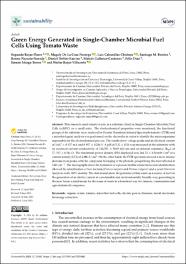Mostrar el registro sencillo del ítem
Green Energy Generated in Single-Chamber Microbial Fuel Cells Using Tomato Waste
| dc.contributor.author | Rojas-Flores, Segundo | |
| dc.contributor.author | De La Cruz-Noriega, Magaly | |
| dc.contributor.author | Cabanillas-Chirino, Luis | |
| dc.contributor.author | Benites, Santiago M. | |
| dc.contributor.author | Nazario-Naveda, Renny | |
| dc.contributor.author | Delfín-Narciso, Daniel | |
| dc.contributor.author | Gallozzo-Cardena, Moisés | |
| dc.contributor.author | Murga-Torres, Emzon | |
| dc.contributor.author | Rojas-Villacorta, Walter | |
| dc.contributor.author | Diaz, Félix | |
| dc.date.accessioned | 2023-10-10T15:44:57Z | |
| dc.date.available | 2023-10-10T15:44:57Z | |
| dc.date.issued | 2023-07-03 | |
| dc.identifier.uri | https://hdl.handle.net/20.500.13053/9515 | |
| dc.description.abstract | This research used tomato waste as a substrate (fuel) in Single Chamber-Microbial Fuel Cells (scMFC) on a small scale. The electrochemical properties were monitored, the functional groups of the substrate were analyzed by Fourier Transform Infrared Spectrophotometry (FTIR) and a microbiological analysis was performed on the electrodes in order to identify the microorganisms responsible for the electrochemical process. The results show voltage peaks and an electrical current of 3.647 ± 0.157 mA and 0.957 ± 0.246 V. A pH of 5.32 ± 0.26 was measured in the substrate with an electrical current conductivity of 148,701 ± 5849 mS/cm and an internal resistance (Rint) of 77. 517 ± 8.541 Ω. The maximum power density (PD) displayed was 264.72 ± 3.54 mW/cm2 at a current density (CD) of 4.388 A/cm2. On the other hand, the FTIR spectrum showed a more intense decrease in its peaks, with the compound belonging to the phenolic groups being the most affected at 3361 cm−1. The micrographs show the formation of a porous biofilm where molecular identification allowed the identification of two bacteria (Proteus vulgaris and Proteus vulgaris) and a yeast (Yarrowia lipolytica) with 100% identity. The data found show the potential of this waste as a source of fuel for the generation of an electric current in a sustainable and environmentally friendly way, generating in the near future a mechanism for the reuse of waste in a beneficial way for farmers, communities and agro-industrial companies. | es_PE |
| dc.format | application/pdf | es_PE |
| dc.language.iso | eng | es_PE |
| dc.publisher | MDPI | es_PE |
| dc.rights | info:eu-repo/semantics/openAccess | es_PE |
| dc.rights.uri | https://creativecommons.org/licenses/by/4.0/ | es_PE |
| dc.subject | organic waste; tomato; microbial fuel cells; electric power; biomass; metal electrodes; bioenergy extraction | es_PE |
| dc.title | Green Energy Generated in Single-Chamber Microbial Fuel Cells Using Tomato Waste | es_PE |
| dc.type | info:eu-repo/semantics/article | es_PE |
| dc.identifier.doi | 10.3390/su151310461 | |
| dc.type.version | info:eu-repo/semantics/publishedVersion | es_PE |
| dc.publisher.country | CHE | es_PE |
| dc.subject.ocde | 3.03.00 -- Ciencias de la salud | es_PE |
Ficheros en el ítem
Este ítem aparece en la(s) siguiente(s) colección(es)
-
Web of Science (WOS) [236]


